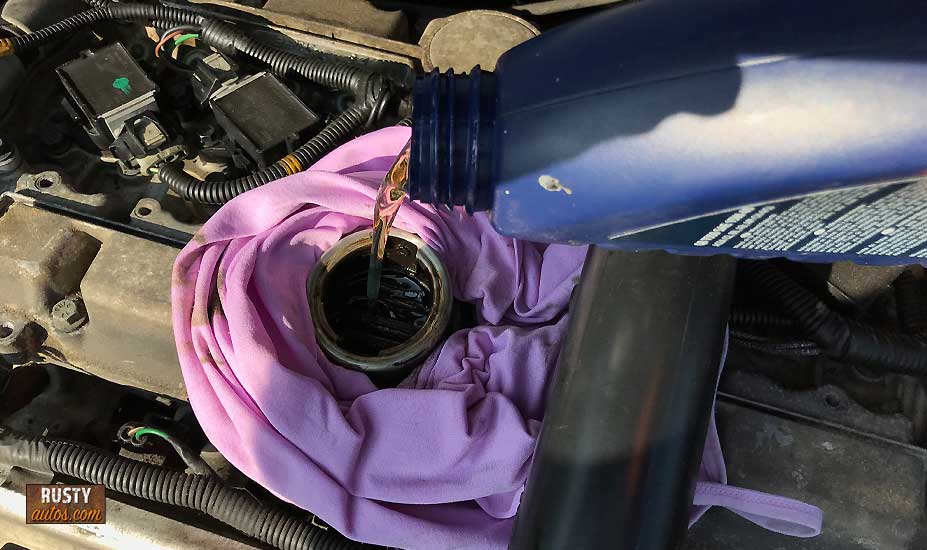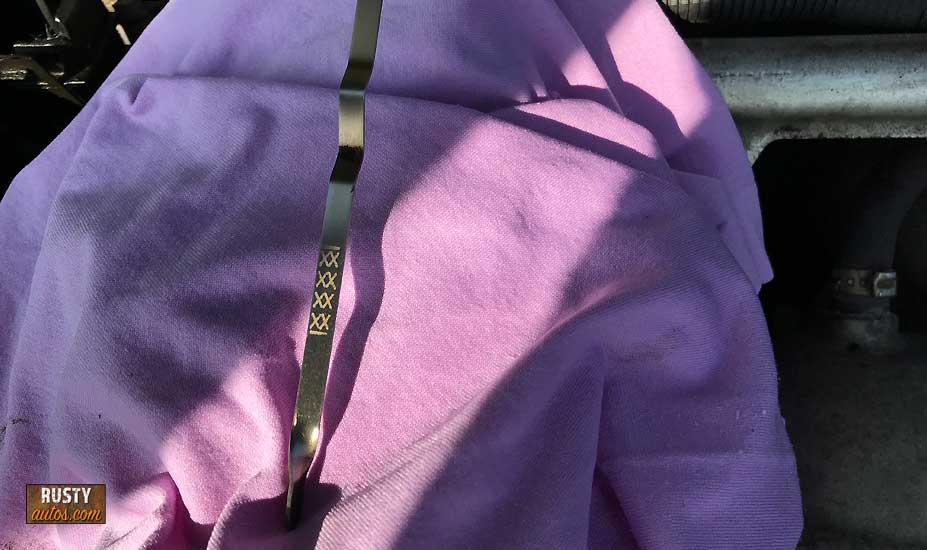Can I Just Put New Oil in My Car
I drive an older classic car and I add new oil to old oil all the time. It's called topping up the engine oil. No substitute for a good oil change, but hey ok oil is better than no oil at all, right?
Adding new engine oil without draining the old oil is an acceptable practice between oil change services. However, a complete oil change should be performed every twelve months or 5,000 miles whichever occurs first.
In this post, you'll learn why it's not okay to add new oil to old oil on a consistent basis. You'll also learn why using the specified oil type is important, how to check the oil, and what to do if you add too much oil.
Adding New Oil To Old Oil

Adding new oil to old is perfectly okay and is an accepted practice for maintaining correct oil levels between oil change services. The oil added should be the oil type recommended by your manufacturer, and that's important.
Constantly adding oil however is not a substitute for changing the engine oil. That's because contaminants in the oil collect in the oil filter but also in the oil pan, without draining the oil pan at every service the contaminants are constantly cycled around the engine.
Oil change intervals depend on your vehicle age and recommendations. More modern car engines are cleaner and use synthetic oils which last a lot longer.
Generally, oil change intervals for more modern cars running fully synthetic oil are between 10 and 15,000 miles. Older cars may be as little as 3,000 miles. But your vehicle's service book will specify the correct mileage between oil changes.
What Oil Type Should I Use?

Which oil to use is a question that causes great confusion to many, and I understand why. There's a ton of different oil types on the market. You can find the oil type recommended easily, it's often printed right on the oil filler cap, in the service book, in the driver's manual, on the manufacturer's website or your parts store can tell you.
But oil is oil, right? Well, no. Manufacturers do a lot of research on their engines before bringing them to market. They choose oil type based on their engines tolerances, where and how their engines are to be used. They choose the oil type that has proven to offer the best protection.
Oil makes the inside of your engine slippy, it coats components with a layer of oil which causes them to glide on the oil surface and not metal to metal contact.
Slippy means less friction and that prevents engine wear and promotes engine efficiency.

But oil does more than reduce friction. The oil contains detergents to help clean your engine and chemicals that neutralize harmful acids that build up inside your motor. The acids are a natural byproduct of burning gasoline but are harmful to the engine.
The correct oil type is super important to a performance engine. Their tolerances tend to be smaller (clearance between moving engine parts) and therefore proper lubrication is critical, especially when pushing on.
An oil's viscosity or ability to flow is important to your motor. Too thin and it won't coat the components sufficiently. Too thick and it will move like molasses especially in colder temperatures.
Weather plays a part too, when temperatures are low oil has a harder time moving around the tiny passages of your engine. Colder climates require a lighter oil blend and conversely hotter climates require a heavier blend of oil.
That's quite a conundrum for engine designers, the solution is a blend of free-flowing oil for the colder temperatures and a thicker oil for the higher temperatures. And that's why there are so many oil types in the parts store aisle.
Oil graded by its ability to flow

Oil is graded by its ability to flow at lower and higher temperatures. 0W30 and 5w30 are common grades.
The first number, "5" identifies how vicious or how the oil flows at lower temperatures (W for winter) and the 30 represents how the oil flows at higher temperatures. The lower the numbers the thinner the oil.
Your car requires the oil type the manufacturer recommends, which you'll often find on the oil filler cap. While using a different brand won't do immediate damage to your engine, but over the longer term, it may, especially as engine deposits build up.
Bear in mind manufacturers may not stand over a warranty claim unless the owner can prove the specified oil type was used at every service interval.
How To Check Engine Oil
Checking the engine oil level is a critical maintenance habit every vehicle operator should develop. It takes only a few moments and could save you thousands in repair costs. A car engine won't run without oil, within minutes it will score bearings and generate enough friction heat to fuse moving parts together.
To check an engine successfully you'll need to follow a few basic rules, you won't need tools, just a clean rag. But first, we'll need to find the dipstick.
Finding and reading a dipstick

Most vehicles will have a dipstick but not all. Some models use an oil level monitoring sensor in the engine oil pan to check the oil level. The oil level on these cars may be checked from the driver's information module (Dash clock) Every system is a little different, but you can check the process in your driver's manual.
For vehicles with a dipstick (most), you'll find it somewhere obvious. Many manufacturers make a feature of its location. In any event, the dipstick handle is usually brightly colored and employs an oil symbol or the word oil.
Some older vehicles may have a second dipstick for transmission oil checks, but it too will be marked transmission oil.
Dipsticks are vehicle-specific and typically employ three important marks towards the bottom end of the stick.
- A full mark – Desired oil level
- A hatched or knurled area – Oil level OK in this area
- A low oil mark – Add oil immediately

The full and low marks may come in the form of letters such as "F" and "L". dimples, cutouts, slashes, etc.
The upper and lower marks represent full and low oil levels and the hatched area in between represents an oil level that's acceptable. However, the aim is as you know to fill oil to the full mark.
You may find this post helpful, I cover oil checking and filling in more detail, "Is it hard to change your own oil?"
The oil checking possess is as follows:
- Park vehicle on level ground
- Allow engine to cool a little
- Pop hood
- Locate the dipstick and remove
- Clean the dipstick and refit
- Remove the dipstick and read level
How To Add Engine Oil

To add engine oil you'll need to first find the oil filler cap. Like the dipstick, the filler cap will be marked with either the word oil or an oil symbol.
You may find this post helpful, I cover oil filling in more detail, "Is it hard to change your own oil?"
Adding Too Much Engine Oil
Adding too much oil is easy to do, adding a little and dip to check is the best way to prevent adding too much oil. An overfilled oil condition can cause the engine to develop oil leaks and cause the engine to smoke from the tailpipe.
A little too much oil isn't an issue but filling the oil way above the full mark will need to be removed.
How to remove too much engine oil?

To remove the excess oil you have two choices. Drain the excess oil through the oil drain plug or siphon the oil out through the dipstick.
Siphoning is a ton less work but will require a siphon, you can check out the one I use here on the Mechanics tools page.
Using the siphon to suck out the excess oil is easy and mess-free. Remove the dipstick and thread the siphon tube into the dipstick tube until it stops, pump the siphon and watch the oil flow. Remove and check the oil level and repeat as needed. Easy!
Draining the oil out will require some tools and jacking the vehicle up. Typical tools required include:
- Jack
- Axle stands
- Ratchet and socket set
- Oil drain
The process of draining looks like this:
- Jack vehicle and support with axle stands
- Remove lower splash cover
- Remove oil plug and drain off a quart of oil
- Lower the vehicle to the ground before checking the oil level
- Repeat as necessary
You're a pro!
Can I Just Put New Oil in My Car
Source: https://rustyautos.com/ok-adding-new-oil-without-draining-mechanics-view/